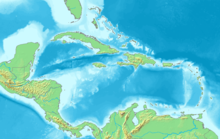Battle of St. Lucia
| Battle of St. Lucia | |||||||
|---|---|---|---|---|---|---|---|
| Part of the American Revolutionary War | |||||||
 Barrington's Action at St Lucia, 15 December 1778 , Dominic Serres | |||||||
| |||||||
| Belligerents | |||||||
|
|
| ||||||
| Commanders and leaders | |||||||
|
|
Comte d'Estaing | ||||||
| Strength | |||||||
|
7 ships of the line 3 frigates |
12 ships of the line 4 frigates | ||||||
| Casualties and losses | |||||||
| 230 killed and wounded | 850 killed and wounded[1] | ||||||
Location within Caribbean | |||||||
The Battle of St. Lucia or the Battle of the Cul de Sac was a
Background
The French had entered the American Revolutionary War on behalf of the rebels and were conducting actions in the Caribbean to try to take over British colonies there. On 7 September 1778, the French governor of
On the evening of 13 December and morning of 14 December,
Battle

Admiral Barrington was alerted to the presence of the French fleet by the frigate Ariadne and organised his line of battle so that Isis and his three frigates (Venus, Aurora, and Ariadne) were close to shore guarding the windward approach, and he placed his flagship, Prince of Wales, toward the leeward.[1] Barrington, in a defensive strategy, placed his transports inside the bay but behind his battle line, which took him the entire evening of 14 December. By 1100 hours the next day, most of the transports had been safely tucked behind his line.[4]
At 1100 hours 15 December Admiral d’Estaing approached St. Lucia with ten ships of the line, and was fired on by one of the shore batteries. D’Estaing moved to engage Barrington from the rear, and a "warm conflict" raged between the two fleets, with the British supported by two shore batteries.[1] D’Estaing was repulsed but succeeded in reforming his line of battle. At 1600 hours d’Estaing renewed his assault by attacking Barrington's centre with twelve ships of the line. Again, heavy fire was exchanged, and the French were eventually repulsed for a second time.[9]
Outcome
On 16 December Admiral d’Estaing appeared to be preparing for a third assault against Admiral Barrington's line, but then sailed away towards the windward.[1] On the evening of 16 December d’Estaing anchored in Gros Islet Bay, where he landed 7,000 troops for an assault on the British lines at La Vigie. Three assaults were made but British control of the high ground enabled them to repulse the French. The French troops were re-embarked, and when d'Estaing's fleet left on 29 December, the island surrendered to the British.[10]
Order of battle
French line of battle
| Vice-amiral d'Estaing' squadron[11] | |||||||
|---|---|---|---|---|---|---|---|
| Division | Ship | Type | Commander | Casualties | Notes | ||
| Killed | Wounded | Total | |||||
Zélé
|
74
|
Barras Saint-Laurent | |||||
Tonnant
|
80 | Bruyères-Chalabre (flag captain) Breugnon (Lieutenant général) |
|||||
| Marseillais | 74
|
La Poype-Vertrieux | |||||
| Languedoc | 80 | Vice-amiral )
|
|||||
| Hector | 74
|
Moriès-Castellet | |||||
| César | 74
|
Castellet (flag captain) (WIA)[12] Broves (chef d'escadre) |
|||||
| Fantasque | 64
|
Suffren
|
|||||
Guerrier
|
74
|
Bougainville | |||||
| Protecteur | 74
|
Saint-Germain d'Apchon | |||||
| Vaillant | 64
|
Chabert-Cogolin | |||||
| Provence | 64
|
Desmichels de Champorcin | |||||
| Sagittaire | 50 | Albert de Rions | |||||
| Reconnaissance and signals | |||||||
| Chimère | 32-gun frigate | Cresp de Saint-Césaire | |||||
Engageante
|
26-gun frigate | Gras-Préville | |||||
| Alcmène | 26-gun frigate | Bonneval[13] | |||||
| Aimable | 26-gun frigate | Saint-Eulalie[14] | |||||
British line of battle
| Ship[5] | Rate | Guns | Commander |
|---|---|---|---|
| HMS Prince of Wales | Third rate
|
74 | Admiral Samuel Barrington Captain Benjamin Hill |
| HMS Boyne | Third rate
|
70 | Captain Herbert Sawyer
|
| HMS Preston | Fourth rate
|
50 | Commodore William Hotham Captain Samuel Uppleby |
| HMS St Albans | Third rate
|
64 | Captain Richard Onslow |
| HMS Nonsuch | Third rate
|
64 | Captain Walter Griffith |
| HMS Centurion | Fourth rate
|
50 | Captain Richard Braithwaite |
| HMS Isis | Fourth rate
|
50 | Captain John Raynor |
| HMS Venus | Fifth rate
|
36 | Captain James Ferguson |
| HMS Aurora | Sixth rate
|
28 | Captain James Cumming |
| HMS Ariadne | Sixth rate
|
20 | Captain Thomas Pringle |
Notes
Citations
- ^ ISBN 1-55750-623-X
- ISBN 978-0-7614-2569-4.
- ^ a b Ekins, Charles. The Naval Battles of Great Britain: From the Accession of the Illustrious House of Hanover to the Throne to the Battle of Navarin. Baldwin and Cradock, 1828; p. 91.
- ^ a b Ekins, p. 93.
- ^ a b Ekins, pp. 91–93.
- ISBN 978-0-313-33536-5.
- ^ Cunningham, George Godfrey (1853). A History of England in the Lives of Englishmen. A. Fullarton. p. 133.
- ^ Wilson, James Grant, and John Fiske. Appletons' Cyclopaedia of American Biography. D. Appleton, 1900; p. 5:109.
- ^ Ekins, pp. 92–93.
- ISBN 1-86176-012-4.
- ^ Troude (1867), p. 19.
- ^ Troude (1867), p. 41.
- ^ Contenson (1934), p. 142.
- ^ Contenson (1934), p. 167.


